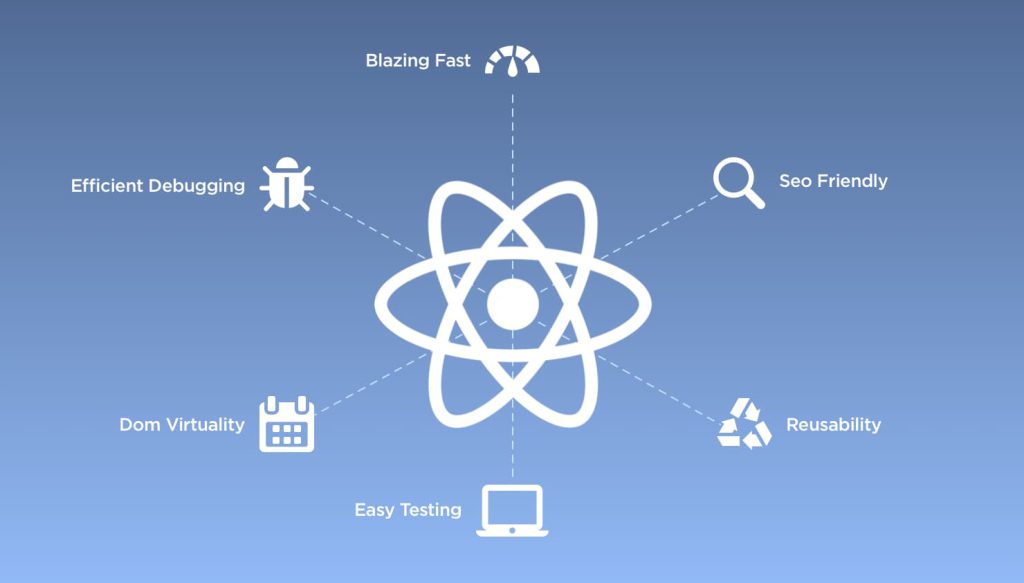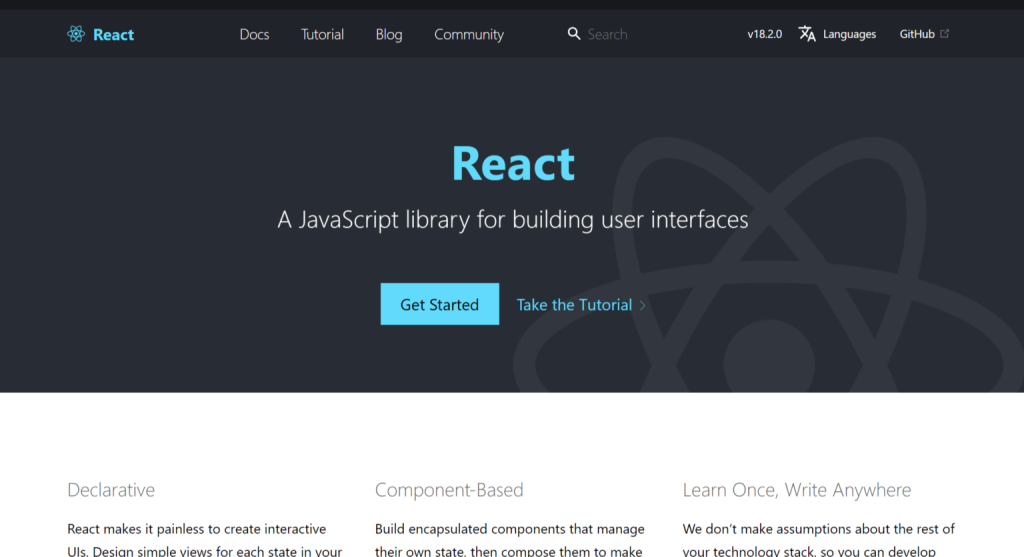Today, React is widely used by most companies and front-end developers to ease the development process of web applications. But what is React, what are the features of React, and why you should use ReactJS?
In this article, we will explain what React is and why many front-end developers use it. In addition, we describe the benefits of using React and explain why it is essential to participate.
What is React?
React is a well-known open-source JavaScript library developed in 2011 by Jordan Walke, a senior engineer at Facebook, and has since become one of the most popular front-end design tools. It is often used for building single-page and mobile applications.
React allows developers to create reusable UI components. It works by breaking the UI into small, independent pieces called “components,” which can be composed to build complex UIs. This makes building and maintaining applications easy, as the components can be easily shared and reused throughout the application.
React uses a virtual DOM (a JavaScript representation of the actual DOM) to optimize updates to the actual DOM. This makes it faster than other JavaScript libraries that manipulate the DOM directly.
React also follows a unidirectional data flow, which means that the parent component passes data down to its children via props (short for “properties”). The children cannot directly modify the props they receive. This helps prevent unexpected behavior in the application and makes it easier to reason about its state.
What are the features of React?

As we said, React is one of the most popular and widely used libraries in the front end. In the following, we explain the most important features that have made this library popular among the developer community.
Virtual DOM
Websites use HTML to update the DOM, which is basically a map of the layout of the requested web page. This is not a problem when working with simple, static websites. But using HTML to update dynamic websites that constantly interact with the user has some drawbacks. Because with every change in the page, the whole page needs to be reloaded.
React solves this problem using a virtual DOM and allows fast, scalable, and simple page changes. A virtual DOM is a copy of the website’s original DOM, and React uses the virtual copy to update only the parts of the original DOM that need to be changed.
This approach requires less loading time and computing power and makes web applications more efficient. This approach won’t make much of a difference on mostly static sites, but on websites that are heavily modified with dynamic features and items, using a virtual DOM makes a significant difference.
JSX (JavaScript XML)
Browsers read the HTML codes of websites and then display them as web pages. Browsers create a DOM during the reading process. To improve the user experience, developers usually add dynamic content to pages by modifying the DOM.
JSX is a JavaScript extension for React that allows developers to manipulate and enhance the DOM using HTML code easily. Using JSX to update the DOM can improve site performance and development efficiency. Since React supports all modern browsers, JSX is also compatible with all browsers.
React Native libraries
Native libraries provide the famous React architecture for Native applications such as Android and iOS, allowing developers to take advantage of its rich UI features and functional components. React Native also allows using components written in Java, Swift, or Objective-C.
One-way data flow
One of the important features of React is its use of a one-way data flow. So, developers cannot edit any component directly. They should use the callback function to make changes to the components. This process is called “properties flow down, actions flow up.” A one-way data flow helps developers to have better control over the web or mobile application, which increases the flexibility and optimization of the application.
The React community
React is a free and open-source project with a strong community of developers contributing to improving and modifying its source code. This has given React developers access to many features to create user interfaces. If they encounter a specific problem, they can get help from libraries already created by other developers.
Why you should use ReactJS?

There are countless open-source libraries and frameworks in front-end development, all of which offer great features to facilitate the development process and improve the end product and user experience. React is still one of the most popular front-end libraries in such a competition. Its outstanding features compared to other frameworks have made it one of the leading technologies used by front-end developers. Here are some of the main benefits of using React.
Easy to learn
React is easy to learn. So developers can jump into projects much faster. This makes React not only a helpful tool but also an affordable one. Any developer with even basic knowledge of JavaScript can build beautiful applications in React after a few days of training.
Component-based approach
In React, websites are built using building blocks, Components such as UI components, and even more complex functions such as stage management. React’s component-based approach makes it easy for developers to design and build professional mobile and web applications.
Native approach
As mentioned earlier, developers can easily create apps for native platforms with React Native’s extensive reusable code. Once you understand the basic React architecture and thinking, you can develop fully functional apps for both Android and iOS without having to learn two different ways to develop your apps.
Efficiency and testability
React applications have excellent and easy testability. React allows developers to inspect the output while executing events, functions, etc. This feature makes the debugging process simple and accurate. Additionally, the virtual DOM feature in React can improve the performance of websites, especially with larger and more dynamic user interfaces.
React has no container to solve dependency problems. However, to overcome these problems, a set of different modules like Require JS, ECMAScript 6, and Browserify can be used to inject dependencies automatically.
Declarative
Declarative programming is a programming paradigm in which the programmer describes what the program should do rather than how it should do it. React’s declarative nature means describing the UI you want to see on the screen, and React takes care of the rest. For example, consider the following code:
render() {
return <h1>Hello, World!</h1>;
}
In this code, the programmer tells React that they want to render an h1 element with the text “Hello, World!” on the screen. The programmer does not need to worry about how React will do this. They need to describe the desired outcome.
Declarative programming can make understanding and maintaining the code easier because you can focus on what the code is doing rather than how it is doing. It can also make it easier to reason about the code because you can think about the problem you are trying to solve at a higher level. This feature enhances the developer experience. Improving the developer experience is often an overlooked issue that will ultimately lead to improved user experience.
Simplicity
React is small in size and can be downloaded quickly. Its simple configuration and the code-splitting feature will improve the user experience, especially in larger projects. Additionally, search engines prioritize websites with less loading time, and React can optimize websites for SEO by improving their loading time and overall performance.
Flexibility
React code is flexible and easy to maintain due to its modular structure. Therefore, using React increases applications’ scalability, and time and cost are reduced in the long run. Additionally, the extensive libraries developed by the React community allow developers to create great user interfaces.
Backward compatibility
Unlike many other frameworks or languages, React provides backward compatibility for developers. Backward compatibility is an important feature when choosing software. The ability to update or work with older software versions saves development time and prevents many problems.

Conclusion
In this article, we addressed the questions of why you should use ReactJS and what are the features of React. We discussed that React is a JavaScript library for creating smooth and dynamic user interfaces. React is a powerful library that improves the designer experience and is easy to learn and work with. React has every tool you need to create a fast-loading, high-performance user interface. React’s virtual DOM enables fast handling of user requests without frequent updates and optimizes web pages for SEO purposes. React is also backward compatible, meaning its old versions do not cause unnecessary problems.
Although React has some bugs, it is still one of the best and safest libraries to use for the front-end development of your applications, especially if you want to create a web application with long-term support, high speed, and dynamic features.


